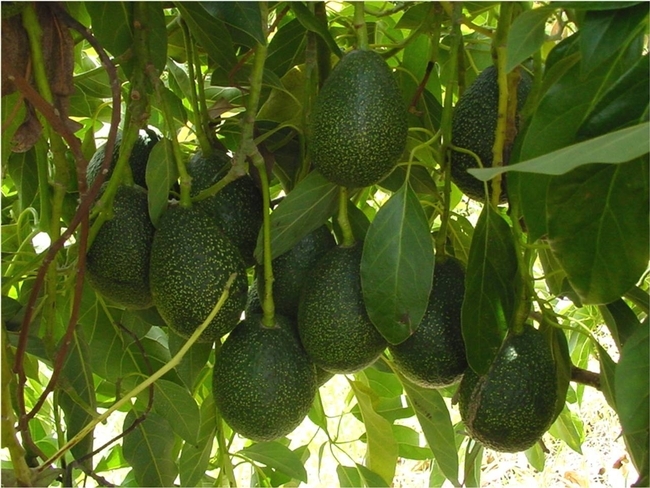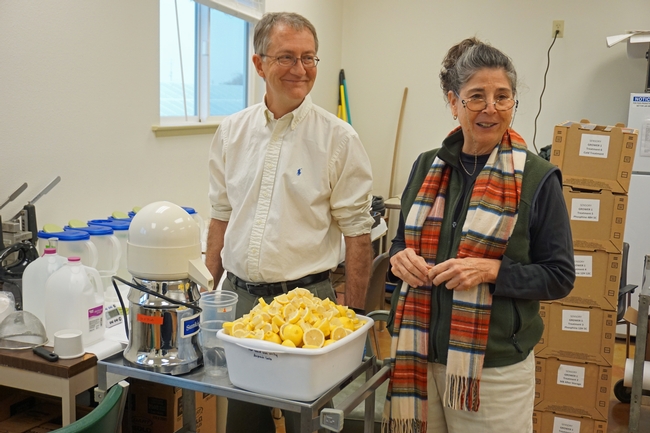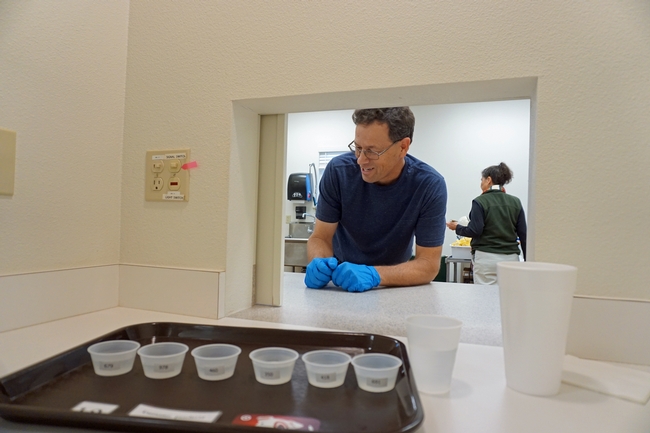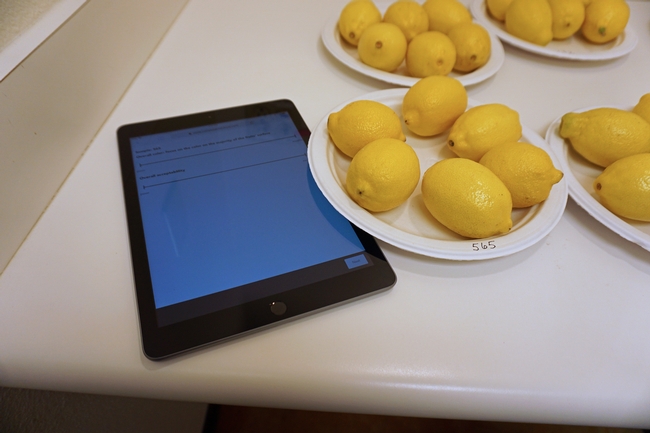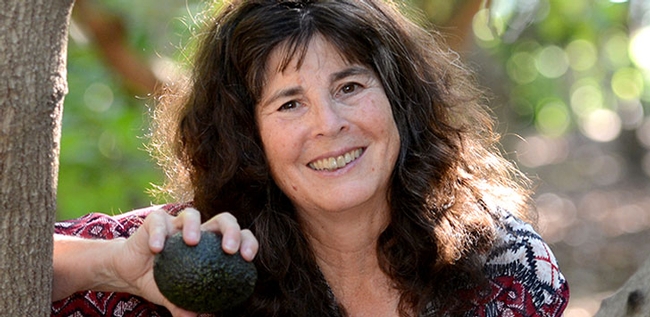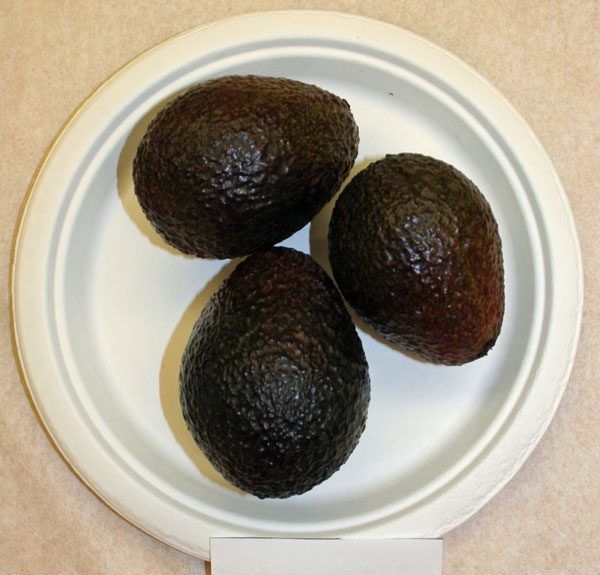Posts Tagged: Mary Lu Arpaia
Avocado tasters are wrapping up a their work at UC sensory lab
A group of trained and dedicated volunteers have been tasting avocado samples at the UC Kearney Agricultural Research and Extension Center in Parlier to determine whether the GEM avocado variety can stand up to the tried-and-true Hass in grocery stores, reported Dale Yurong on ABC 30 Action News.
Yurong visited the sensory lab at Kearney where nine tasters have been meeting for months to help inform UC and USDA research that may enable commercial production of avocados in the San Joaquin Valley, an area believed to be unsuitable because of hot summers and cold winters.
The panellists identify avocado characteristics like nutty, stringy and buttery. "You're getting into the texture, you're getting into a lot of different nuances of flavor," said taster Shannon Aguilar.
GEM avocados grow on smaller trees than Hass and GEM has a tear-drop shape, while Hass is more pear-shaped. But the real test will be comparable flavor and tolerance to valley conditions.
"We believe it has a little more heat tolerance and a little more cold tolerance," said UC Cooperative Extension specialist Mary Lu Arpaia.
The GEM may give local farmers a new crop option. One has already planted two acres of GEM.
"It's something that we probably need in this area. Something we can do and we wouldn't have to import it from other parts of the country or the world," said Marvin Flores, environmental health and safety specialist at Kearney and a member of the avocado taste panel.
Lemon water tasting at UC research center kicks off an 18-month citrus sensory study
What flavors do you detect in a sip of lemon water? Are there notes of sweetness, sour, off flavors or fresh citrus taste? Scientists at the UC Kearney Agricultural Research and Extension Center and the USDA want to know every subtle taste sensation for a research project continuing over the next 18 months.
Participants will taste the major types of citrus to confirm that treatments used to eliminate pests in overseas shipments don't have an impact on fruit enjoyment. Lemon tasting will be followed by mandarins, navel and Valencia oranges, and grapefruit.
“This work is critical for the citrus industry,” said Mary Lu Arpaia, UC Cooperative Extension specialist in subtropical fruit. “A huge amount of California citrus is exported, but if there are quarantined pests in the shipment, that triggers treatments with a fumigant.”
In the past, importers treated citrus with methyl bromide. However, the pesticide has been phased out because it depletes the ozone layer. An alternative fumigant, phosphine, kills the insects, but scientists don't yet know what impact the chemical will have on the fruit.
“We're hoping there's no taste difference,” Arpaia said. “But we don't know. That's why we're doing the testing.”
USDA plant physiologist David Obenland, based at the USDA office across the street from Kearney in Parlier, is working with Arpaia to conduct the study at Kearney's sensory laboratory. The 1,100-square-foot laboratory features neutral white paint and broad-spectrum lighting; the ventilation system minimizes distracting odors. Six tasting booths each have small windows that open to the kitchen area, where samples are prepared.
“Previous research has resolved residue issues and determined phosphine is effective in killing the pests,” Obenland said. “But they didn't fully determine whether the process would hurt the fruit.”
The current project compares fruit treated with methyl bromide, phosphine and a cold temperature protocol in which the fruit is held just above freezing for three weeks. In addition to tasting the fruit, volunteers evaluate the fruit's appearance.
“People buy with their eyes,” Arpaia said. “We're asking our participants to compare the fruit visually to see if they detect any differences.”
The research is funded by the California Citrus Quality Council through a grant from the USDA Foreign Agricultural Service.
May 2018 News Clips
Mien farmers get advice for growing strawberries in Yolo County
(Woodland Daily Democrat) ANR news release, May 31
Abnormal Weather Takes a Toll on California Olive Crop
(Ag Net West) Brian German, May 30
The late winter freeze caused significant issues for several different commodities throughout the state and has been especially problematic for the California olive crop. The fluctuating temperatures have created substantial concern among the industry as bloom looks to be far below normal levels.
“Overall we're a little on the pessimistic side. The bloom, on the whole, has been pretty poor, many orchards actually have a very light, to next to no bloom at all,” said Dani Lightle, Cooperative Extension Orchard Systems Advisor for Glenn County. “There's an orchard here or there that looks pretty good, but on the whole, it is a little bit dismal.”
http://agnetwest.com/weather-takes-toll-california-olive-crop/
How Avocados Define LA and the Secret to Making the Best Damn Avocado Toast
(LA Taco) Gab Chabran, May 29
…Eric Focht who is a staff research associate in the lab of Mary Lu Arpaia at UC Riverside through UC Agriculture and Natural Resources and the Department of Botany and Plant Sciences tells L.A. Taco that the recent avocado economy boom is “similar to what we see today with something like bitcoin.” He helps run a breeding program at UCR studying different avocados varieties, focusing mostly on Hass avocados but also looking at other less known versions of the popular fruit.
In short, he is working on breeding the perfect avocado that tastes great and is easier, faster, and less water-dependent to grow. This year is shaping out to be a good one for avocados, but this issue is always one to keep in mind.
Focht states that in the future, there will likely be more variety available in the mainstream marketplace. One varietal that Focht gets excited about is the Reed avocado which has now been popping up in places such as Whole Foods. It's known for its round, dinosaur egg shape and is about the size of a softball. It has a relatively large seed but the edible flesh is sometimes double or even triple that of a Haas that can make a lot more people happier per individual fruit.
http://www.lataco.com/how-avocados-define-l-a-and-the-secret-to-making-the-best-damn-avocado-toast/
Amazing graze
(Chico News & Review) Ashiah Scharaga, May 24
When drifting clouds dapple the sky and vibrant wildflowers—tickled pink buds, honey-hued petals and virent stems—awaken in the verdant fields of Table Mountain, explorers quicken their pace. They spot trickling streams and grazing cattle. Occasionally, they look straight down, turning anxious eyes to their mud-slicked heels—did they step in one of the fertile cow-pie mines littered across the landscape?
That may seem a nuisance, but it's a necessity. Tracy Schohr, a livestock and natural resources adviser for University of California Cooperative Extension, said the natural magic of the popular Butte County recreational spot is made possible because of a long-standing grazing program. “If cattle were not actually on Table Mountain Ecological Reserve,” she said, “essentially those invasive species would choke out those native plants, and they wouldn't be there.”
… In the past, grazing was misunderstood and primarily viewed as destructive, said Dave Daley, a fifth-generation Butte County cattleman and associate dean of Chico State's College of Agriculture. He credits changing perspectives to the development of grazing science, fueled by people such as Schohr and Kate Wilkin, a UC Cooperative Extension forestry, fire science and natural resource adviser for Butte, Yuba, Sutter and Nevada counties. (Schohr covers Butte, Plumas and Sierra counties.)
https://www.newsreview.com/chico/amazing-graze/content?oid=26315855
Sheep Shearing 101: Why Aspiring Shavers Flock to This California School
(KQED) Tiffany Camhi, May 23
…“We try to get the students shearing the first day because they make a lot of mistakes,” says John Harper, head of the UC Cooperative Extension Sheep Shearing School in Hopland.
Harper says if you can make the right moves with your feet, everything else falls into place.
“We're dancing instructors,” says Harper. “It's like 'Dancing With The Stars' on steroids, but with sheep.”
Around this time of year, hundreds of thousands of sheep in California need to have their wool shaved off. But Harper says there's a shortage of sheep shearers worldwide.
That's why he started the school in Hopland about 25 years ago.
Dan Macon of the California Wool Growers Association says the growing popularity of backyard flocks in California (usually just a handful of sheep) is adding to the demand for shearers, too.
“Infrastructure of the sheep industry is a key component,” says Macon. “Having people with that kind of skill and willingness to work hard is desperately needed.”
AUDIO: Hey, Salad Lovers: It's OK To Eat Romaine Lettuce Again
(NPR Morning Edition) Allison Aubrey, May 23
…After a big foodborne illness outbreak linked to baby spinach back in 2006, the leafy greens industry put in place a number of procedures to prevent contamination. "Prevention became the major focus after that outbreak," says Michele Jay-Russell, a food safety researcher at the University of California, Davis.
"They set up intensive testing protocols to monitor water quality," Jay-Russell says. The industry also agreed on standardized setbacks — or buffers — to separate growing fields from livestock operations, which can be a source of E.coli contamination. "You want a safe distance from where you're growing fresh produce and where you have concentrations of animals, like on a feedlot or dairy," she says.
Are avocados toast?
(Grist) Nathanael Johnson, May 22
…When Katherine Jarvis-Shean was a doctoral candidate researching the decline of cold winters a few years back, she thought more farmers should be freaking out. “I used to think, ‘Why aren't you guys more worried about this? It's going to be the end of the world.'”
After all, many fruit and nut trees require a good winter chill to bear fruit. But after spending a few years as an extension agent for the University of California — working directly with farmers and translating science into techniques they can apply on the land — she understands better. It comes down to this: Farmers have a ton of concerns, and the climate is just one of them.
“If you decide what to plant based on climate, but then can't make the lease payment, that's not sustainable,” Jarvis-Shean said.
https://grist.org/article/whatll-we-eat-in-2050-california-farmers-are-placing-bets/ https://www.wired.com/story/are-avocados-toast/
Lanternflies Eat Everything in Sight. The U.S. Is Looking Delicious.
(New York Times) Zach Montague, May 21
…Native to Asia, lanternflies first appeared in Pennsylvania in 2014. Despite a quarantine effort, they have also been discovered in small numbers in New York, Delaware and Virginia.
… “Most pests deposit their eggs on their host plant, or very close, so they already have food available,” said Surendra Dara, an adviser at the University of California Cooperative Extension.
“Those that have the advantage of being able to lay eggs on non-plant material obviously have a better chance of surviving and spreading,” he added.
https://www.nytimes.com/2018/05/21/science/lanternflies-pennsylvania-crops.html
Garbanzos are catching on in Yolo County
(Woodland Daily Democrat, Ag Alert) Bob Johnson, May 19
…“The largest part of our crop goes to canning, maybe 90 percent,” said Paul Gepts, UC Davis plant sciences professor and legume breeder. “California can only compete with high quality products. We have other varieties with higher yields, but the seeds are too small. The growers get a premium for larger, high quality seeds.”
Gepts developed the two newest UC garbanzo varieties, Vega and Pegasus. Both have large, attractive seeds well suited for the canning market, and both have resistance to Ascochyta blight, a fungal disease that can devastate the crop.
… “I think growers are more interested in garbanzos because it's a winter crop, and wheat prices are low,” said Rachael Long, UC Cooperative Extension farm adviser in Sacramento, Solano and Yolo counties. Long is finishing up UC's first Garbanzo Production Manual, which should be available before the end of the year.
http://www.dailydemocrat.com/article/NI/20180519/NEWS/180519787
A French Broom smack-down
(Napa Valley Register) Elaine de Man, May 18
…If we all pull together and pay attention, we can eradicate French broom and send it packing. But it's going to take many, many hands and a concerted effort. It's going to take a village.
1. U.C. Agriculture and Natural Resources, Statewide Integrated Pest Management Program, http://ipm.ucanr.edu/PMG/PESTNOTES/pn74147.html
Kale, Not Jail: Urban Farming Nonprofit Helps Ex-Cons Re-enter Society
(New York Times) Patricia Leigh Brown, May 17
Even by the standards of the Bay Area, where sourcing local, organic chicken feed is seen as something of a political act, the spectacle of 30,000 fruit and nut trees being tended by formerly incarcerated orchardists is novel.
…Jennifer Sowerwine, an urban agriculture specialist for the University of California Cooperative Extension at Berkeley, said that Ms. Haleh and Mr. Raders have “shifted the conversation around food justice.”
“It's not just about food security, but the security of providing living wages,” she said. That's no mean feat in a foodie monoculture.
https://www.nytimes.com/2018/05/17/business/urban-farming-exconvicts-recidivism.html
Tough winter weather devastates local cherry, blueberry crops
(Bakersfield Californian) John Cox, May 16
It's hard to say at this point just how much damage blueberry fields and cherry orchards sustained during the winter, said Ashraf El-kereamy, viticulture and small fruits advisor with the University of California Cooperative Extension in Kern County.
Machines take over for people at Napa vineyard
(Capital Press) Tim Hearden, May 14
In the heart of the Napa Valley, a vineyard produces fine Cabernet Sauvignon with virtually no help from laborers.
The 40-acre “touchless vineyard” was established by Kaan Kurtural, a University of California Cooperative Extension specialist who has devoted much of his career to improving production efficiency in vineyards as labor shortages have worsened.
…When Kurtural started experimenting with vineyard automation 10 years ago, his primary goal was to save growers money in labor costs, he said. But since then, research has shown that grape quality is superior, largely because the tall canopy protects grapes from sun damage, he said. The system also uses less water than others, he said.
Dozens of strawberry growers gather in Santa Maria to learn latest industry advancements
(KSBY Staff) May 9
More than 100 farmers and growers took park in a meeting teaching them on the best way to grow a healthy strawberry.
The University of California put on the annual event which was free to the public.
Growers discussed improvements handling weeds, disease, and insects.
The Santa Maria Valley is the second largest strawberry growing area in California after the Salinas Valley.
The crop means a lot to people in Santa Maria.
"We've got a number of challenges to the California strawberry industry and we're doing are best to work together," said Steven Fennimore of University of California Cooperative Extension Agriculture and Natural Resources. "I'm optimistic that we'll find some satisfactory solutions."
Growers talked about all kinds of different ways to boost their crop including ways of using images from aircraft to detect stress in plants.
Pesticide Use on California Farms at Near-Record Levels
(Fair Warning) Paul Feldman, May 9
…Some experts say long-term changes in the mix of items farmers produce in California, including increases in almonds and other high value crops, give the agriculture industry the incentive to use more pesticides. Such crops present “a larger economic risk if pests are not controlled,”said Brad Hanson, a weed specialist at the University of California, Davis, plant science department.
Jim Farrar, director of the University of California's statewide integrated pest management program, added that more pesticides are needed when “you move from something like alfalfa and sorghum for dairies, where cosmetic injury isn't a problem … to something like oranges where if there's a blemish on the rind you get downgraded even if the orange is perfectly healthy.”
https://www.fairwarning.org/2018/05/pesticides/
Cherry growers expect lighter crop yields
(Ag Alert) Ching Lee, May 9,
…Kari Arnold, a University of California Cooperative Extension farm advisor in Stanislaus County, said she's careful not to paint the 2018 cherry season as a disaster year "because it's really not." The crop may not be as robust, she said, but this was somewhat expected, because last year's crop was so big.
What wasn't expected, she said, was the freeze in the spring, which "did cause some damage to flowers." But the damage varied depending on the location of the orchard and whether growers were able to apply frost protection, she added.
"It's still going to be a good crop," she said. "It may not be the same as last year, but they're going to be good cherries. They're probably going to sell at a higher price because there'll be less of them."
She said she's concerned that word of it being a light crop may scare away field help, adding that "it's hard enough to get field labor in the first place anymore, because labor is becoming more and more difficult to come by and more difficult to keep."
http://www.agalert.com/story/?id=11854
Peak Avocado Is Yet to Come
(The Atlantic) Cynthia Graber, Nicola Twilley, May 9
…Its partners in evolution—the giant, elephant-like gomphotheres and three-ton ground sloths that dined on its fruit in return for transporting and then pooping out its giant seed—went extinct soon after the first bipedal apes arrived in the region. Rodents, jaguars, and eventually humans stepped in as dispersal mechanisms, albeit significantly less effective ones. The flourishing avocado forests that carpeted much of Mesoamerica dwindled and died out. And, as Mary Lu Arpaia, who runs the avocado breeding program at the University of California at Riverside, explained, the avocado became a backyard fruit, enjoyed by first the indigenous peoples and later the conquistadors, but rarely cultivated intensively—until recent decades.
https://www.theatlantic.com/science/archive/2018/05/peak-avocado-is-yet-to-come/559883/
Climate change ruining California's environment, report warns
(SF Chronicle) Peter Fimrite, May 8, 2018
“If I were going to look across North America, ground zero for climate change is the Arctic. It is just changing really, really rapidly,” said Steven Beissinger, professor of conservation biology at UC Berkeley. “But California is an important laboratory to understand the effects of climate change on biodiversity.”
https://www.sfchronicle.com/news/article/Climate-change-ruining-California-s-12899272.php
More illnesses with later onset dates linked to romaine outbreak
(The Packer) Ashley Nickle, May 8, 2018
Richard Smith, a University of California Cooperative Extension advisor based in Salinas, also said the outbreak is hurting sales.
“It's having an effect,” Smith said May 7. “This is the problem — lettuce is pretty expensive to grow, and you've got to cover your costs. You can lose money, at this point the bigger growers can afford to lose for a period of time, but then they've got to make it up, and it just makes it hard. We're not sure how the year's going to go.
“I guess the good news is that the consumers are being sophisticated enough to be focusing on the romaine (versus all lettuce) ... The reality is I guess the FDA doesn't want to clear romaine yet because they think that the lettuce from Yuma might have a 21-day shelf life, so until the FDA clears it and then that news gets clearly articulated, I think it's going to be a damper.
https://www.thepacker.com/article/more-illnesses-later-onset-dates-linked-romaine-outbreak
AEI economists say farmers have ‘beef' with Trump
(Hagstrom Report) May 7, 2018
…Daniel Sumner of the University of California at Davis also told The Hagstrom Report that farmers hurt by the administration's trade policies have "a beef" with Trump.
Sumner said that even though the tariffs on Chinese steel and aluminum have not yet gone into effect, California farmers including wine and almond producers are already worried. "Even if the tariffs don't happen, the rhetoric has effects," he said.
Sumner also said that Mexican buyers of U.S. dairy products — "reasonable business people in Mexico" — began months ago to contact New Zealand dairy producers about becoming a supplier because the Mexicans are worried about the impact of the North American Free Trade Agreement renegotiation.
https://www.thefencepost.com/news/aei-economists-say-farmers-have-beef-with-trump/
City Visions: Tech and the future of smart, sustainable farming
KALW, May 7, 2018
Host Ethan Elkind and guests explore the impact of new technologies on our agricultural industry.
What are the biggest challenges to our current food production system? And, how are Bay Area innovators meeting these challenges while promoting sustainability, efficiency and profitability?
Guests:
- Charles Baron, co-founder and vice-president of product at Farmer's Business Network.
- Jaleh Daie, Ph.D., founder and chair of AgriFood Tech and partner at Aurora Equity.
- Glenda Humiston, Ph.D., vice president of University of California's Division of Agriculture and Natural Resources.
http://kalw.org/post/city-visions-tech-and-future-smart-sustainable-farming#stream/0
Workshop planned on Napa fire prevention and best practices
(Napa Valley Register), May 7, 2018
A one-day seminar is planned for May 30 to look at the Napa ecosystem's recovery after the October wildfires and what policies are needed to reduce future fire impacts.
The workshop will be Wednesday, May 30, from 8 a.m. to 3:45 p.m. at Napa Valley College's Performing Arts Center, 2277 Napa Vallejo Highway.
Cost is $15 per person, with registration required at http://ucanr.edu/napafireworkshop2018. For more information, call 530-666-8143.
The program is sponsored by UC Cooperative Extension, Napa County Farm Bureau and the U.S. Department of Agriculture's Natural Resources Conservation Service.
Egg prices plunge as supplies rebound
(Capital Press) Tim Hearden, May 4
Commercial egg prices in California are plummeting, and a slow global economy combined with a rebounding chicken flock after last year's devastating avian flu outbreak are among the contributing factors.
…At first, Midwestern egg producers that didn't want to retrofit their barns simply avoided California. Those that did want to market to California found confusion in what actually constituted a Proposition 2-compliant cage, said Joy Mench, a University of California-Davis animal science professor.
“(T)he wording of Prop. 2 does not allow it to be regulated, so there is no official definition of what it means,” Mench said in an email. “That will have to be decided in the courts, either because there is a lawsuit or because someone is prosecuted.”
In enforcing the initiative, the CDFA uses the federal Shell Egg Food Safety rule, whose space requirement is larger than the United Egg Producer guidelines that most of the other states use, noted Maurice Pitesky, a poultry specialist at the UC-Davis School of Veterinary Medicine.
http://www.capitalpress.com/Business/20160504/egg-prices-plunge-as-supplies-rebound
Farming takes center stage at Yolo County Fairgrounds
Woodland Daily Democrat) Cutter Hicks, May 4
Field trips to the fairgrounds led to a farming experience for students as the Yolo County 4-H and Farm Bureau hosted its 10th annual Farm Connection Day to kick off the Spring Show this weekend.
The four-hour event Friday featured more than 100 agricultural displays and hands-on activities for kids of all ages as nearly 2,500 visitors walked through the gates.
Farm Connection Day was open to the public and more than 200 4-H students teamed up to host the event — with a little help from adult volunteers. Their focus was to teach students of Yolo County the aspects of the organization before judging shows later that day.
DeAnn Tenhunfeld, a Farm Connection Day organizer, said that the attendance was the largest seen since she founded it in 2008.
http://www.dailydemocrat.com/business/20180504/farming-takes-center-stage-at-yolo-county-fairgrounds
Frost damage varied for California nut trees
(Farm Press) Robyn Rominger, May 2, 2018
Some almond growers experienced frost damage from recent freezing conditions, say University of California experts.
“There's really a lot of damage,” says Katherine Jarvis-Shean, UC Cooperative Extension orchard systems advisor for Sacramento, Solano, and Yolo counties. “The earlier varieties really took a hit. Some trees even dropped their nuts due to frost damage. It's pretty bad in some orchards.”
… Bruce Lampinen, UCCE almond and walnut specialist, measured temperatures in an almond trial at Davis, and notes that “Feb. 20 and 24 were the coldest days. It was very problematic because that's when the trees were in full bloom.” At full bloom, temperatures below 28 degrees F. can cause crop loss.
…Phoebe Gordon, UCCE orchard systems advisor for Madera and Merced counties, says, “From what I've seen and heard, the damage has been variable. Some orchards weren't hit that hard, and others were hit very hard. I think it depended a lot on micro-climate and what stage the trees were in. They become more susceptible to frost damage as they transition from dormant to full bloom, and to nut set. I don't think we'll really know until ‘June drop' is finished what the final load is.”
Dani Lightle, UCCE orchard systems advisor in Glenn and Butte counties, says, “Almonds were right in the middle of full bloom when the frost happened. Most of the orchards in my area seem to have escaped. We didn't seem to cross the threshold to where there was heavy damage. Of course, there are exceptions, but by and large we came out better in the end than we thought we would.”
http://www.westernfarmpress.com/tree-nuts/frost-damage-varied-california-nut-trees
New weapon in fight against walnut blight
(Farm Press) Robyn Rominger, May 2, 2018
Walnut growers have a new tool to help manage blight disease in their orchards — Kasumin 2L, manufactured by Arysta LifeScience, is the trade name for kasugamycin, and is available as part of a strategy to control the disease.
The new bactericide was discussed at a recent University of California Cooperative Extension breakfast meeting at Yuba City. “It's great to have another chemistry in the rotational loop for blight management in walnuts,” says Emily Symmes, UCCE integrated pest management advisor.
http://www.westernfarmpress.com/tree-nuts/new-weapon-fight-against-walnut-blight
Avocados go from Meso-American backyards to 'world domination'
Avocados, now riding a tide of popularity appearing on toast in cookbooks and trendy restaurant menus, came late to commercial agriculture, reported Cynthia Graber and Nicola Twilley in Gastropod, a podcast that looks at food through the lens of science and history.
The 48-minute story features Mary Lu Arpaia, UC Cooperative Extension specialist based at the UC Kearney Agricultural Research and Extension Center in Parlier. Arpaia runs the UC avocado breeding program and is now studying varieties that will do well in the San Joaquin Valley climate.
On Gastropod, Arpaia outlined avocados' humble beginnings in their native Mexico and Central America.
"It was grown as a dooryard crop tree and valued for thousands of years," Arpaia said. "There was no intensive production of avocado until the industries in California and Florida started about 100 years ago."
The most popular variety is the Hass, which is derived from a seed planted in La Habra Heights by a hobby horticulturist, Rudolph Hass, a U.S. Postal Service worker.
"The thing against it (the Hass variety) was it turned black when ripe. It's a great tree with great fruit, but it's black," Arpaia said. "So it just shows how things have changed."
Consumers now embrace Hass' black, bumpy coat.
Graber and Twilley spent time on the show describing the "avocado toast" sensation around the globe. The duo quoted an article in Vogue that says 3 million new pictures of avocado toast are uploaded to Instagram every day.
The future for avocados looks bright. Already China imports 32,000 tons of avocados annually, but the market potential is much greater.
"I can't even imagine how big avocado will get in China," said one of the Gastropod hosts.
UC researchers look to expand California avocado production
California avocados are the best in the world. So says downtown restaurant manager Daniel Avalos in a Valley Public Radio story by reporter Ezra David Romero.
The fact that they currently thrive only on a small swath of coastal Southern California is being challenged by UC Cooperative Extension specialist Mary Lu Arpaia. She is on a mission to find avocado varieties that withstand the hot summers and cold winters of the San Joaquin Valley, where irrigation water and crop land are more abundant and cheaper.
She hopes to find avocado varieties that ripen at various times of year, and varieties that might be an alternative crop for citrus growers should huanglongbing, a disease that has devastated the Florida citrus crop, take hold in Central California.
"There's a void of California fruit on the market in the months of November, December and actually early January," Arpaia said. "So if we can find different selections that maybe are unique that fit into that window, then we help the entire California avocado industry."
Romero visited the UC Lindcove Research and Extension Center to see the trees in Arpaia's study. Currently, the vast majority of California avocados are the Hass variety. The goal is to breed varieties with similar eating quality that grow to a moderate height and have high yield. One potential that is already being produced by nurseries is called "gem."
"This is gem," said Eric Focht, a staff research associate in Arpaia's lab. "You can see it's a little more oval or egg shaped than Hass. It has the speckling on the skin. Now as this ripens, it will turn dark and a lot of times the speckled lenticels with get a yellow kind of golden color it it."
Another promising variety is called "lunchbox" because of its small size. According to Focht, it "just falls out of the skin." Arpaia said, "It makes wonderful guacamole and I found, with a non-replicated test in my refrigerator, the fruit doesn't brown."
Arpaia's favorite guacamole recipe is featured at the end of the story on the KVPR website.

